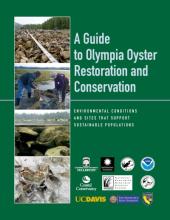
Oysters are the tiny superheroes of coastal environments. They enhance water quality, create habitat, and protect shorelines from storms and erosion. Along the Pacific Coast, native oysters are in decline, due in part to sedimentation, inadequate protection, and unsustainable harvests. Planning for a future that includes healthy native oyster populations depends on our ability to select sites for restoration that not only account for these challenges but also the impacts of a changing climate. A 2011 Collaborative Research project led by the Elkhorn Slough and San Francisco Bay Reserves helped to meet this need by developing science-based planning tools that decision-makers along the Pacific Coast can use to select local “sweet spots ” for restoration in which oysters can thrive under current and future conditions.
This guide identifies the key environmental conditions that affect Olympia oysters, informed by a qualitative assessment of 28 embayments across much of the range of the species on the Pacific Coast. This report enhances understanding of the attributes of sustainable oyster populations, the environmental conditions that most strongly affect them, and the embayments and specific sites best support them - a valuable tool for all those interested or involved in native oyster restoration on the Pacific Coast.
This report and a companion report for Central California are also available through the San Francisco Bay Subtidal Habitat Goals Project
Wasson, Kerstin, Chela Zabin, Jillian Bible, Sara Briley, Elena Ceballos, Andrew Chang, Brian Cheng, Anna Deck, Ted Grosholz, Alicia Helms, Marilyn Latta, Bree Yednock, Danielle Zacherl and Matt Ferner. 2015. A Guide to Olympia Oyster Restoration and Conservation: Environmental Conditions and Sites that Support Sustainable Populations. Report published by the Elkhorn Slough National Estuarine Research Reserve